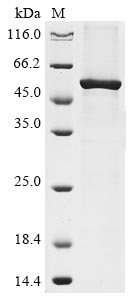Recombinant Human Aminopeptidase N (ANPEP) is produced in E. coli with an expression region spanning amino acids 34 to 219. This partial protein carries an N-terminal 10xHis-GST tag and a C-terminal Myc tag, which help with purification and detection. The purity exceeds 85%, as verified by SDS-PAGE analysis, ensuring reliable performance in research applications.
Aminopeptidase N (ANPEP) is an enzyme that appears to play a significant role in peptide substrate metabolism. It cleaves amino acids from the N-terminus of peptide chains—a process that seems important for protein maturation and recycling. ANPEP also participates in various cellular pathways, making it a valuable research target for studying enzymatic function and regulation.
Potential Applications
Note: The applications listed below are based on what we know about this protein's biological functions, published research, and experience from experts in the field. However, we haven't fully tested all of these applications ourselves yet. We'd recommend running some preliminary tests first to make sure they work for your specific research goals.
Human ANPEP is a type II membrane glycoprotein that requires precise folding, disulfide bond formation, and extensive glycosylation for its functional enzymatic activity. The E. coli expression system cannot provide the necessary eukaryotic post-translational modifications (particularly glycosylation) and complex folding environment required for this membrane-associated protein. The large N-terminal 10xHis-GST tag (∼26 kDa) may sterically interfere with the protein's functional domains, while the partial fragment (34-219aa) lacks the complete structural context. The probability of correct folding with enzymatic activity is very low.
1. Antibody Development and Validation Studies
Antibody development relies on antigenic sequence recognition rather than functional folding or glycosylation. This recombinant ANPEP fragment serves as an excellent immunogen for generating antibodies against linear epitopes of human aminopeptidase N. The partial sequence provides substantial epitope coverage for antibody production. However, antibodies may not efficiently recognize conformational or glycosylation-dependent epitopes on the native, properly folded protein found in physiological conditions.
2. Structural and Biophysical Characterization
Basic biophysical characterization can be performed to assess the protein's physical properties. Techniques like circular dichroism spectroscopy can analyze secondary structure content, while size-exclusion chromatography can determine oligomeric state. However, these studies will characterize a non-glycosylated, misfolded protein rather than the native, glycosylated enzyme.
3. Tag-Based Detection System Development
Tag-based detection relies on tag antigenicity rather than native protein folding. The combination of His, GST, and Myc tags makes this protein valuable for developing and optimizing multi-tag detection systems. The protein serves as an excellent positive control for testing antibody specificity and assay development.
Final Recommendation & Action Plan
The E. coli expression system is fundamentally unsuitable for producing a functional version of this complex membrane glycoprotein due to its glycosylation requirements and membrane association needs. This recombinant ANPEP fragment is primarily suitable for antibody development against linear epitopes (Application 1) and tag-based detection system development (Application 3). Avoid interaction studies entirely due to the high probability of misfolding. Protein-protein interactions require precise tertiary structure and proper glycosylation, which this bacterially expressed fragment cannot provide. Application 2 (biophysical characterization) can provide basic physical property data, but will not reflect native protein characteristics. For reliable ANPEP functional studies, use mammalian expression systems that support proper glycosylation and membrane targeting, or work with native protein purified from biological sources where correct post-translational modifications are preserved. Begin with basic biophysical characterization to confirm protein integrity, then proceed with linear epitope antibody production and tag-based assay development. All functional applications require alternative protein sources with proper glycosylation and membrane association.






